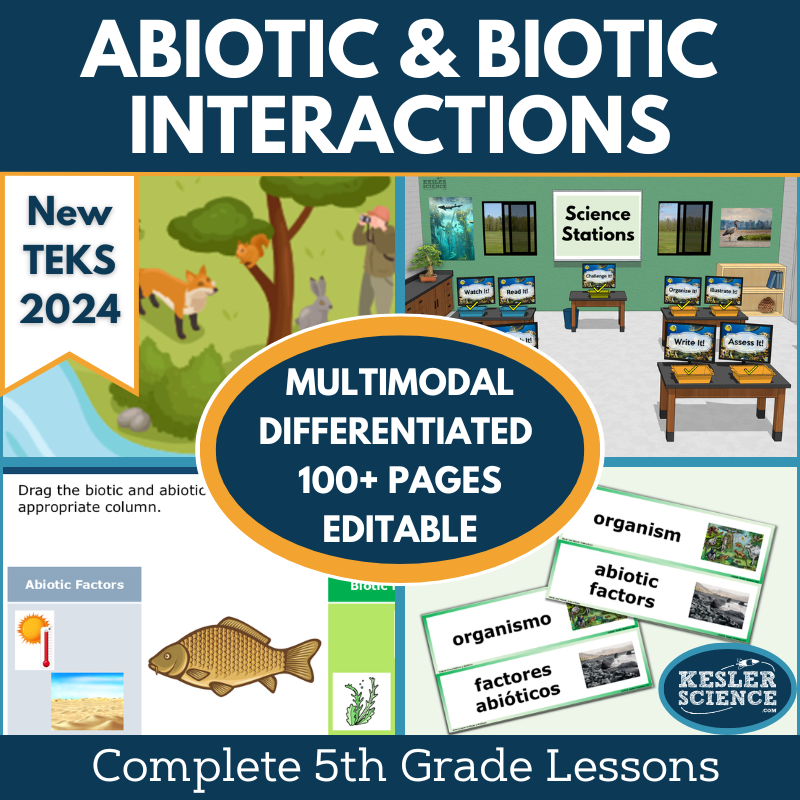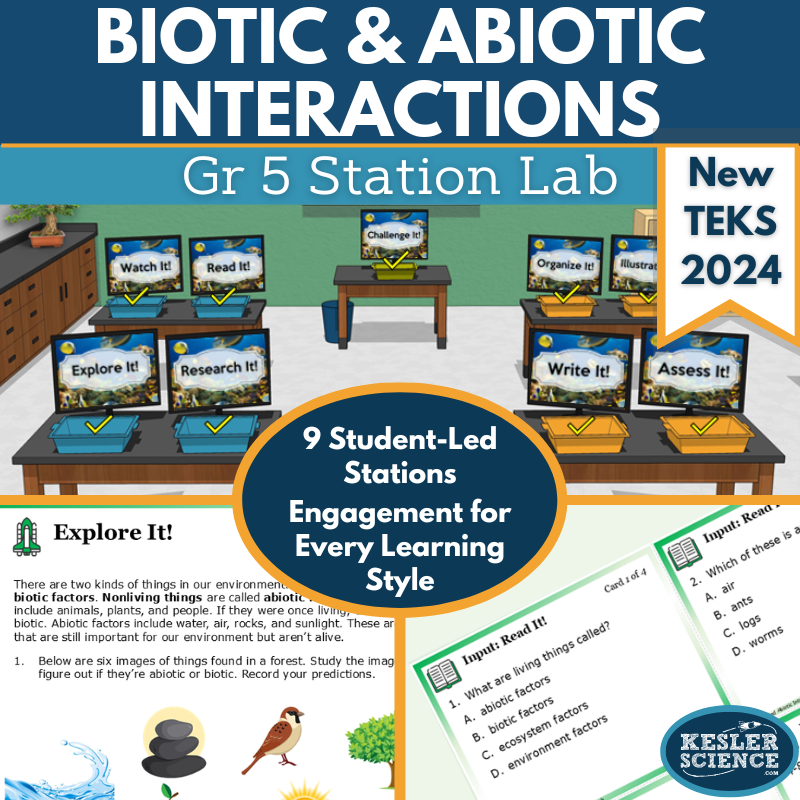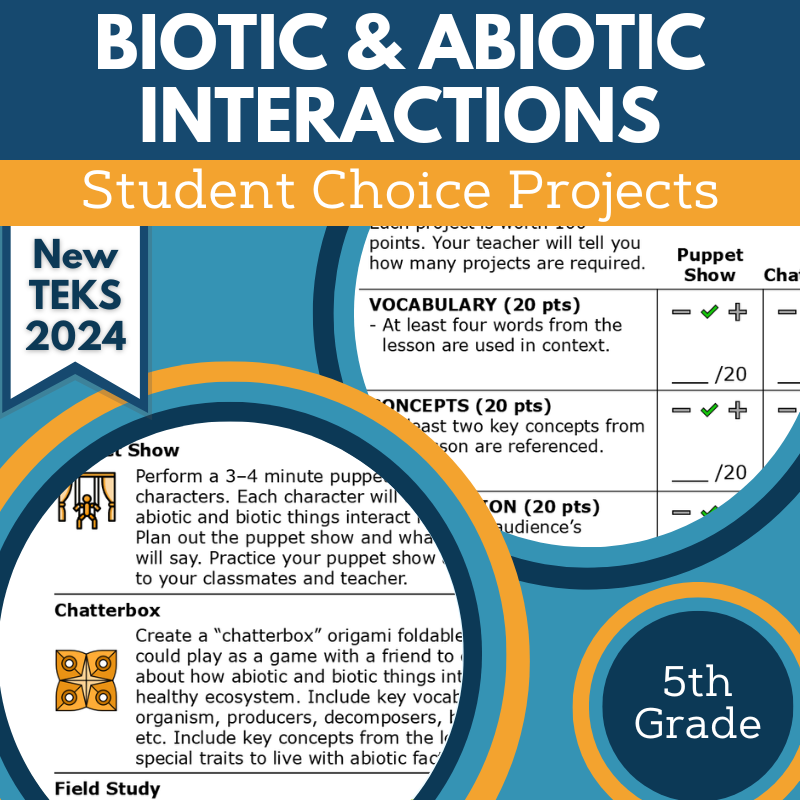Biotic & Abiotic Interactions Activities for 5th Grade Science
This Kesler Science Biotic & Abiotic Interactions 5E Lesson helps students explore how organisms interact with biotic and abiotic factors in an ecosystem. The resources below will give students a comprehensive understanding of biotic and abiotic interactions. All of the following materials are also included in the Kesler Science Membership.
The Kesler Science Biotic & Abiotic Interactions 5E Lesson covers how organisms interact with biotic and abiotic factors in a healthy ecosystem. This fully editable, low-prep unit includes presentations, worksheets, choice projects, and assessments, making it perfect for differentiated, student-led learning. Aligned with the 2021 TEKS 5.12A, the unit is flexible for both in-class and virtual settings.
Students explore key questions about ecosystem health, the roles of biotic and abiotic factors, and how organisms rely on each other for survival. The lesson features a hands-on station lab with differentiated activities, such as reading, experiments, videos, and research tasks. Output stations allow students to demonstrate their understanding through writing, sorting, drawing, and formal assessments. Bonus extension activities are included for early finishers.
Additionally, students can engage with editable PowerPoints, interactive notebooks, and various templates in English and Spanish. The lesson also offers student-choice projects to reinforce learning. Assessment questions are aligned with STAAR 2.0 for test preparation, and the materials are designed to be flexible for different learning environments.
The Kesler Science Biotic & Abiotic Interactions 5E Lesson covers how organisms interact with biotic and abiotic factors in a healthy ecosystem. This fully editable, low-prep unit includes presentations, worksheets, choice projects, and assessments, making it perfect for differentiated, student-led learning. Aligned with the 2021 TEKS 5.12A, the unit is flexible for both in-class and virtual settings.
Students explore key questions about ecosystem health, the roles of biotic and abiotic factors, and how organisms rely on each other for survival. The lesson features a hands-on station lab with differentiated activities, such as reading, experiments, videos, and research tasks. Output stations allow students to demonstrate their understanding through writing, sorting, drawing, and formal assessments. Bonus extension activities are included for early finishers.
Additionally, students can engage with editable PowerPoints, interactive notebooks, and various templates in English and Spanish. The lesson also offers student-choice projects to reinforce learning. Assessment questions are aligned with STAAR 2.0 for test preparation, and the materials are designed to be flexible for different learning environments.
This student-led activity for the 2021 TEKS 5.12A standard on biotic and abiotic interactions in ecosystems keeps 5th graders engaged while learning about how organisms survive through their interactions with both biotic and abiotic factors. The modular, differentiated stations allow students to direct their own learning, with nine activities designed to help them explore and understand ecosystem interactions.
The stations include multimodal ways for students to engage with the material. At the Explore It! station, students apply their knowledge through activities, while the Watch It! station offers a video on biotic and abiotic factors. The Read It! station provides differentiated reading passages and vocabulary practice, and Research It! offers facts and graphs to help students understand the impact of factors like temperature and pollution on ecosystems.
Output stations give students multiple ways to demonstrate their understanding. At Organize It!, students work with manipulatives or digital tools to represent concepts, while Illustrate It! allows them to sketch a healthy ecosystem. The Write It! station asks students to respond to prompts using complete sentences, and Assess It! tests their knowledge with task cards and questions. A bonus station, Challenge It!, offers extension activities for advanced learners.
This resource is adaptable for both in-person and virtual learning environments.
This student-led activity for the 2021 TEKS 5.12A standard on biotic and abiotic interactions in ecosystems keeps 5th graders engaged while learning about how organisms survive through their interactions with both biotic and abiotic factors. The modular, differentiated stations allow students to direct their own learning, with nine activities designed to help them explore and understand ecosystem interactions.
The stations include multimodal ways for students to engage with the material. At the Explore It! station, students apply their knowledge through activities, while the Watch It! station offers a video on biotic and abiotic factors. The Read It! station provides differentiated reading passages and vocabulary practice, and Research It! offers facts and graphs to help students understand the impact of factors like temperature and pollution on ecosystems.
Output stations give students multiple ways to demonstrate their understanding. At Organize It!, students work with manipulatives or digital tools to represent concepts, while Illustrate It! allows them to sketch a healthy ecosystem. The Write It! station asks students to respond to prompts using complete sentences, and Assess It! tests their knowledge with task cards and questions. A bonus station, Challenge It!, offers extension activities for advanced learners.
This resource is adaptable for both in-person and virtual learning environments.
The Abiotic and Biotic Relationships Student Choice Projects align with the 2021 TEKS life science standard 5.12A, offering 5th graders the chance to choose a project that matches their preferred output style. The project page includes six different student-led options, plus a “design your own” project. An editable rubric is provided for assessment by teachers, peers, or the students themselves.
These flexible projects allow for differentiation, with a modified version for students needing remediation and challenge options for advanced learners. Teachers can adjust the rubric to suit grading needs. The projects offer creative ways for students to demonstrate understanding using standard classroom supplies like paper, markers, and scissors, with many options available for digital completion.
The Abiotic and Biotic Relationships Student Choice Projects align with the 2021 TEKS life science standard 5.12A, offering 5th graders the chance to choose a project that matches their preferred output style. The project page includes six different student-led options, plus a “design your own” project. An editable rubric is provided for assessment by teachers, peers, or the students themselves.
These flexible projects allow for differentiation, with a modified version for students needing remediation and challenge options for advanced learners. Teachers can adjust the rubric to suit grading needs. The projects offer creative ways for students to demonstrate understanding using standard classroom supplies like paper, markers, and scissors, with many options available for digital completion.
Year-Round Resources
These year-round activities will increase your students' understanding of many middle school science topics. All of these activities are also included in the Kesler Science Membership.
Visual Data & Graphing
You're not alone if your students struggle with understanding graphs, charts, and tables. It's a skill that takes an enormous amount of practice. This resource will help students build a strong foundation in analyzing data and creating their own data visualizations.
Bell Ringers and Warm-Ups
These middle school science bell ringers are an excellent way to engage your students as soon as they walk into your classroom. This comprehensive FULL YEAR resource includes everything you need to start off each science class with an interesting warm-up activity.
Review Board Games
Each game board has been carefully designed to keep students engaged. There are 10 different action spaces on each board and dozens of question cards. All of the actions are related to science concepts and keep the students motivated throughout the game.
Each game is ready to play. Simply print out the board and the cards and let the students enjoy reviewing nine different units.
Essential Questions and Standards
Below are the essential questions and standards associated with the lessons and activities included in the atoms unit. This topic is only one of more than 100 middle school science topics included in the Kesler Science Membership.
-
What observations can we make about organisms and their interactions with abiotic and biotic factors in a healthy ecosystem?
-
What makes an ecosystem healthy?
-
TEKS Science - 5.12A Biotic & Abiotic Interactions
Kesler Science Membership
Imagine never having to search for another middle school science lesson again. The membership gives you access to ALL of the Kesler Science products in one place (Yes, including everything above).
Say goodbye to long hours of lesson prep.







